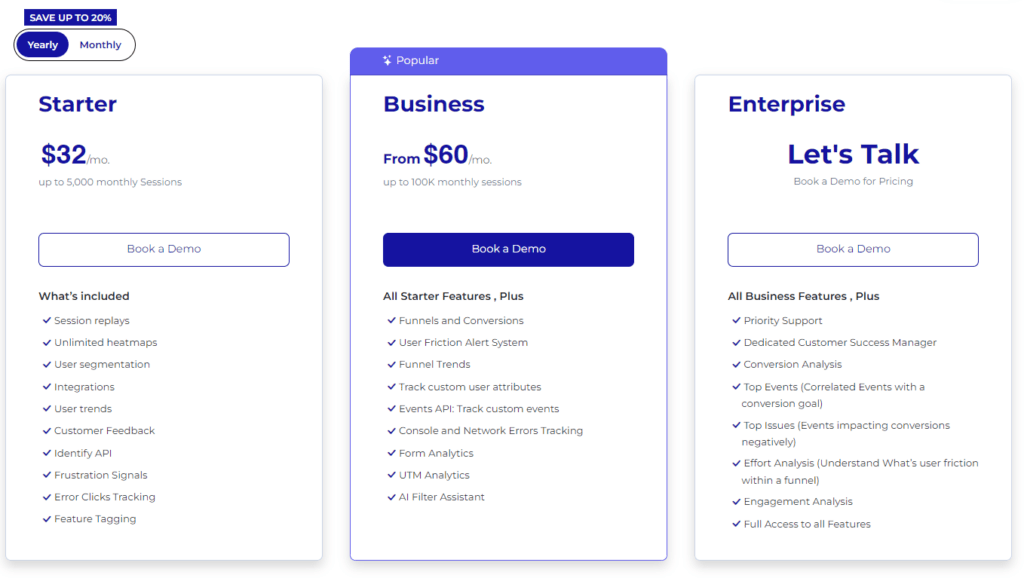Are you looking to optimize your website's performance but unsure if VWO is the right choice? You're in luck! We've compiled...
Do you know what motivates your customers to buy?
Demographics provide valuable information that helps shape your ideal customer profile and learn more about your target audience. It tells you who your customer is through broad categories like age, location, and race. But while all this data is important, it doesn't tell you why your customers buy what they buy.
In comes psychographics, which tells you the psychological traits that influence your customers to buy. This article will delve deeper into the definition of psychographics, the most common examples, and how to utilize psychographic data.
What are Psychographics?
Psychographics dives deep into the psyche of your target audience, exploring the reasons behind their actions.
Unlike demographics, which focus on objective characteristics based on age, gender, and location, psychographics focus on subjective data like attitudes, interests, personality traits, values, and opinions that make individuals' decision-making processes.
Psychographics Examples
When collecting psychographic information, there are a lot of subjective parameters to choose from. Here are five of the most common:
Personality
An individual's personality is a collection of traits, thoughts, and feelings they exhibit or experience consistently over time. The most common way to categorize people's personalities is by using the five-factor model of personality or the OCEAN model.
According to this model, the Big 5 personality traits are extroversion, agreeableness, openness, conscientiousness, and neuroticism.
For example, people who score low on extroversion tend to prefer solitude and run out of social battery faster than their peers.
Interests
Interests include hobbies, media preferences, and other things that people spend a lot of time on. Obviously, interests vary widely from person to person, but the target audience will likely share a few interests that can be integrated into marketing campaigns.
Lifestyle
Lifestyle refers to the way a person lives, including their daily activities, core beliefs, diet, associations, etc. Market research that takes lifestyle choices into account increases the chances of the product being in line with the target customer's day-to-day life.
Attitudes, Opinions, and Beliefs
You can treat these categories as separate psychographic parameters, but it's more practical to lump them all together as they usually tie in with one another.
Someone's attitudes, opinions, and beliefs will dictate how they behave as a consumer, which is why they are worth looking into before conducting a marketing campaign.
For example, a clothing company that finds out a big chunk of its target market is eco-friendly may find better success by focusing on sustainability.
Social Class
Some people categorize themselves as low, middle, and upper-class and make purchase decisions based on their perceived social status.
Psychographic Segmentation Examples
Imagine you’re selling yoga mats. Demographics will tell you your target market is women aged 20-45. On the other hand, psychographics will reveal that your ideal customer values sustainability, spends her free time at group wellness sessions and focus groups, and is willing to pay a lot for products that align with her beliefs.
Right off the bat, you're not just selling yoga mats. You're selling a commitment to wellness and the planet. Collecting psychographic data and utilizing psychographic examples will boost marketing campaigns and hit the target market much more efficiently.
Psychographics vs Demographics
Psychographic data and demographic data are two distinct but complementary approaches used by marketers to understand and segment the target audience. While demographics set the stage, psychographics bring the character to life.
For example, think of demographic data as the skeleton of your research for marketing efforts; it is necessary but not very animated. Psychographics, on the other hand, is the soul. It gives us the reasons behind a purchase, providing insights that are valuable for creating marketing campaigns and strategies.
Psychographic Profiling
Psychographic profiles are descriptions of your target customers' lifestyles, attitudes, behaviors, interests, and other categories that influence buying decisions. These profiles will help you understand who would be most responsive to your marketing messages.
When creating an ideal customer profile, demographic and psychographic profiles go hand in hand. Consumers make decisions based on dimensions from both categories. For example, for a company that sells female yoga clothes, gender is directly correlated to lifestyle; a basic snapshot of their ideal customer profile is someone who wears feminine-presenting clothing and has a passion for yoga.
Using Demographics and Psychographics to Create Customer Personas
Demographics and psychographics can work together to create an actionable buyer profile. In other words, using both quantitative and qualitative analysis will help you clearly understand what motivates your target customers to buy.
Here's a more detailed example:
A clothing company specializes in sustainable shirts, pants, and other basic apparel. The demographic and psychographic profiles of their target customer are:
Demographic profile:
Male or female
Aged 18-35
Lives in a temperate climate
Psychographic profile:
Concerned about the environment and wants to contribute to preventing global warming
Favors quality over quantity when shopping for clothes
Prioritizes comfort over style
Spends a lot of time on social media platforms
From this simple example, the combination of demographic information and psychographic data paints a clear picture of the buyer persona. Demographic data alone won't tell you what influences buyer behavior, so you need psychographics to determine what motivates the target customer to buy.
To continue the example, the company will then create marketing campaigns that focus on the sustainability and comfort of their products while increasing ads on social media.
Finding Psychographic Data
Gathering psychographic data might sound like a very challenging task, but it's easier than you might think.
Here are some of the best ways to collect psychographic data from both new and existing clients:
Interviews
Small talk can get you a long way. Asking existing customers about their hobbies, travel plans, and interests is a great method to learn more about your ideal customer. If you have long-standing clients, you might even get a feel of their personality traits. Gather this information to get to know your market a little bit better.
Focus groups
A focus group consists of participants, usually not associated with the business, who will discuss your products or brand. They should be unbiased and align--if not belong--to your target market. For example, if you sell yoga mats, your focus group should consist of people who consistently do yoga.
You can conduct a focus group discussion and take notes of their opinions, traits, values, etc. Alternatively, you can give participants questionnaires that would help you perform better market segmentation.
Social media
Social media collects mass volumes of data on customers’ personalities, beliefs, as well as attitudes, interests, and opinions (AIOs). In fact, it is one of the primary objectives of social media platforms from a marketing standpoint.
Optimizing your social media strategies can help you gain more knowledge of what your followers are like and what you can do to get them to buy your products.
How FullSession Can Help
Tools like FullSession can help you track user behavioral data on your website, giving you an insight into their preferences and interests. You can see how they interact with your website and determine potential pain points.
Plus, FullSession lets you track user actions that lead to conversions, helping you identify which strategies work and which ones don't.
Here are a few specific tools that streamline psychographic data collection:
Heatmaps: FullSession provides you with a website heat map that will help you see where your visitors are clicking, or more specifically, which items capture their interest the most.
Customer surveys: Use FullSession’s customer feedback tools to collect instant feedback for your website. This can help you identify potential frustration points and improve your customer experience analysis. Additionally, customer reviews will help you get to know your target market a bit more based on what pleases vs. frustrates them.
Segmentation: One of the primary functions of FullSession is to optimize your market segmentation process through web analytics. Analyzing user behavior can give you a good idea of who your customers are while minimizing the guesswork.
4 Steps for Gathering and Using Psychographic Research
To make things easier for your marketing campaigns, FullSession's arsenal of analytical tools can help you find psychographic data. Follow these steps to utilize more psychographic marketing and boost your marketing efforts:
Collect Data: With the use of surveys, social media, and analytics tools, gathering information becomes a lot easier. This also includes looking for patterns in preferences and behavior.
Analyze: Delve deeper into the data to spot common psychographic traits among your audience.
Segment: Group your target audience based on their psychographic factors.
Make Your Strategy: Use the data to customize your marketing efforts, from content creation to email marketing.
FullSession Pricing Plans

Here are more details on each plan.
- The Starter plan costs $39/month or $32/year and allows you to monitor up to 5,000 monthly sessions with up to 6 months of data storage.
- The Business plan costs $75/month or $60/year and helps you to track and analyze up to 100,000 monthly sessions with up to 12 months of data storage.
- The Enterprise plan has custom pricing and offers customizable sessions plus full access to all features.
Final Thoughts
Psychographics is a way to know more about your target audience, allowing you to create a marketing campaign in a way that makes you feel connected on a deeply personal level. For marketers, understanding the psychographics of your audience is not only beneficial but also critical to your success.
But how do you do all this?
FullSession is the web analytics tool you need, providing the information and insights needed to research psychographic data effectively. By incorporating psychographics, you're connecting with your audience in a meaningful way while converting them into loyal customers.
FAQs Related to Psychographics Examples
How does psychographic segmentation improve marketing strategies?
It allows for more targeted and personalized marketing efforts, boosting marketing campaign engagement and conversion rates.
Can small businesses benefit from psychographics?
Yes. Even with limited resources, understanding the psychographic segmentation of your focus group can improve your marketing effectiveness.
Is psychographic data collection expensive?
Not necessarily. Many cost-effective methods, like customer interviews, market research, social media analytics, and gathering quantitative data can provide valuable psychographic insights.





